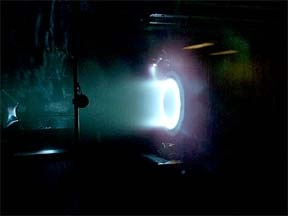NASA looks to solar to power engines for space exploration
 The origins of modern photovoltaics can be found in NASA’s powering of satellites. But now the U.S. space exploration agency is looking to photovoltaics to provide propulsion for space exploration. Most recently the agency asked six companies to explore using photovoltaics to power ion-thrust engines for spacecraft undergoing deep-space missions.
The origins of modern photovoltaics can be found in NASA’s powering of satellites. But now the U.S. space exploration agency is looking to photovoltaics to provide propulsion for space exploration. Most recently the agency asked six companies to explore using photovoltaics to power ion-thrust engines for spacecraft undergoing deep-space missions.
NASA has asked Analytical Mechanics Associates Inc., Ball Aerospace & Technologies Corp., The Boeing Co., Lockheed Martin Space Systems Company and Northrop Grumman Systems Corp. to develop plans for deploying solar electric propulsion systems for future spacecraft.
It will award approximately $3 million with a maximum individual contract award of $600,000, the agency said in a press release.
“Each company will provide a final report to help define a mission concept to demonstrate the solar electric propulsion technologies, capabilities, and infrastructure required for sustainable, affordable human presence in space,” NASA said.
Photovoltaics are being considered to power the engines because they can provide electricity for a much longer period than batteries alone. As part of the research NASA asked the companies to pursue, it also asked them to evaluate which photovoltaics will be the most cost effective.
In the past, most satellites have used germanium-based cells because of their high efficiency levels, but other photovoltaics may offer certain advantages over that technology now. For instance, flexible photovoltaics could be folded for deployment but when unfurled could provide a larger collection area for sunlight.
Spacecraft today use liquid or solid rocket fuel as the power source to break through the earth’s gravitational barrier. These fuel sources require a lot of physical space and add a lot of weight to a spacecraft. Ion-based engines use a lot of electricity, but little actual propellant to generate thrust, which means a smaller amount of propellant could fly a craft much farther in space.
However, some spacecraft already are using ion thrusters. Most are geosynchronous satellites with ion-hull thrusters, used to help the satellites remain in the proper position, according to said Kurt Hack, a NASA chief engineer on the solar-electric propulsion demonstration project.
“Because of that, they’re operating at a much lower power,” he said. “They’ll do some short maneuvers to keep them in their position.”
To provide large amounts of electricity, NASA is looking into solar-electric propulsion systems.
“There are really two classes of thrusters we’re looking at the fit the type of missions we’re [considering],” Hack said. The main engine designs they’re considering are Hall effect thrusters and ion engines.
“The basic concept is you ionize the gas and send it through something to accelerate it,” Hack said.
The gas is ionized with large amounts of electricity using magnetic or electrostatic forces.
“The propellant of choice is a dense, yet easily ionizable material, typically using a noble gas,” he said.
According to Hack, Xenon is the most typically used gas in such engines because it is easier to ionize.
The gas is expelled from the engine at incredibly high speeds, averaging around 20 kilometers per second, providing propulsion. For comparison, the speed of sound, depending on atmospheric conditions, is about 1 kilometer per three seconds.
But because of a slow mass flow, such engines use very little fuel.
“The tank size on board will dictate how long [the engines] can run,” said Cameron Cunningham, NASA project manager with the demonstration project.
NASA plans to announce winners over the next month or so and to receive the studies as early as January 2012, he said.



